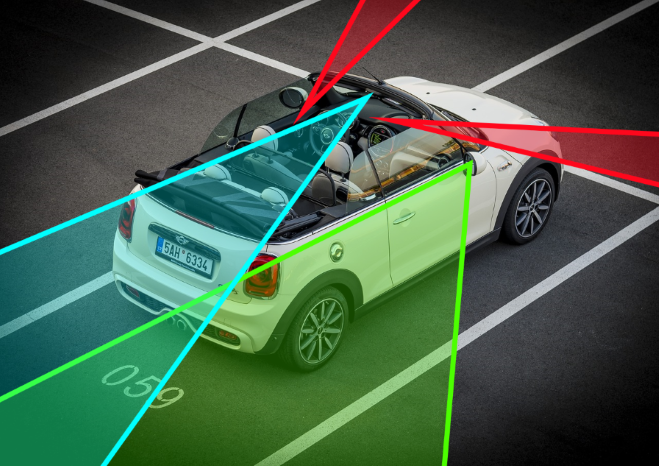
Blind Spot
Causes of blind spots:
Incorrectly aligned mirrors. Vehicle structural pillars. Elevated position of cab. Eye blind spot.
🛈 Info:
💡 Tips:
? Questions:

🛈 Where blind spot is located
🛈 How to check blind spots while driving
Adjust your mirrors: Before you start driving, make sure your mirrors are properly adjusted to give you the widest possible field of view. The side mirrors should be angled to minimize blind spots and provide a view of the adjacent lanes. Use your rearview mirror: Check your rearview mirror frequently to monitor the traffic behind you. This gives you an overall perspective of what's happening on the road. Prepare to change lanes: When you intend to change lanes or merge into another lane, use your turn signal to indicate your intention to other drivers. Signal well in advance to give them ample notice. Perform a shoulder check: As you prepare to change lanes, take a quick glance over your shoulder to check your blind spot. Turn your head and look directly into the area beside and slightly behind your vehicle. This action is often referred to as a "shoulder check" or "head check." Ensure you don't rely solely on your mirrors, as they may have blind spots or limited coverage. Be aware of blind spot zones: The blind spots of most vehicles are typically located to the sides and rear of the vehicle, especially over the driver's right shoulder. Take note of these blind spot zones and pay extra attention when checking those areas. Maintain vehicle control: While performing a shoulder check, it's crucial to maintain control of the vehicle. Keep your hands on the steering wheel and avoid making sudden maneuvers during the check. Complete the lane change: Once you have verified that the lane is clear by checking your blind spot, smoothly and gradually change lanes, taking care to use your turn signal throughout the maneuver.
💡 Tips to mitigate blind spots
Ensure mirrors are properly aligned. If side mirrors are older and limited view, install a special convex mirror onto the inside bottom corner of your side mirrors. Be aware of any blind spots in your vehicle and compensate accordingly. Know that likewise, other vehicles also have blind spots so never assume that other drivers have seen you. Rather start from the premise that you haven't been seen. Be aware of vehicles where the driver is positioned higher off the ground as anything lower than their eye level will be less visible. Before changing lanes, don't rely solely on the mirrors, but if safe to do so, also visually check to the sides or rear. Develop an awareness of what is happening around you. Remember that pedestrians, cyclists and motorcyclists are less visible. Put into practice other Advanced Driving principles found in this course. Aside from the above information, our physical eyes each have a blind spot. See WebMDfor more info.
? Should you turn your head to check blind spots?
Why Check Blind Spots by Turning Your Head
Blind Spots : These are areas around your vehicle that cannot be seen in your mirrors. They can hide other vehicles, cyclists, or pedestrians, posing a potential danger if you don't check them. Mirror Limitations : Even properly adjusted mirrors can’t cover all areas around your vehicle. A quick head check ensures you don’t miss anything in your blind spots. Safety : Turning your head to check blind spots before changing lanes, merging, or making turns helps prevent accidents by ensuring the way is clear.
How to Safely Check Your Blind Spot
Adjust Mirrors Properly : Before driving, ensure your mirrors are adjusted to minimize blind spots. Side mirrors should be positioned so you can barely see the side of your car. Signal Your Intentions : Always use your turn signal to indicate your intention to change lanes or turn. This alerts other drivers of your plans. Check Mirrors First : Look in your rearview and side mirrors to get an initial view of the traffic around you. Turn Your Head : Quickly glance over your shoulder in the direction you intend to move. For a left lane change, glance over your left shoulder; for a right lane change, glance over your right shoulder. This head check should be brief to minimize the time your eyes are off the road ahead. Make Your Move : If the lane is clear, proceed with your maneuver. If there is an obstacle, wait until it is safe to move.
Additional Tips
Practice : If you're not used to checking blind spots, practice in a safe, low-traffic area until it becomes a habit. Be Quick : The head check should be a quick glance, not a prolonged look, to minimize the time your eyes are off the road ahead. Use Technology : Modern cars often come with blind-spot monitoring systems that can help, but they should not replace the manual head check. Stay Alert : Always be aware of your surroundings and anticipate other drivers' actions.
Summary
? What accessory to use to minimize blind spots?
Blind Spot Mirrors
Description : Small, convex mirrors that attach to your existing side mirrors. Function : Provide a wider field of view, allowing you to see areas that would otherwise be in your blind spots. Installation : Typically stick onto the corner of your side mirrors.
Blind Spot Detection Systems
Description : Electronic systems often integrated into modern vehicles or available as aftermarket kits. Function : Use sensors to detect vehicles in your blind spots and alert you with visual or audible warnings. Installation : May require professional installation, especially for aftermarket systems.
Extended Side Mirrors
Description : Larger or extended side mirrors, often used on trucks and larger vehicles. Function : Provide a wider field of view compared to standard mirrors. Installation : Can be installed in place of standard mirrors.
Wide-Angle Rearview Mirrors
Description : Rearview mirrors that are wider than standard mirrors. Function : Provide a broader view of the area behind and to the sides of your vehicle. Installation : Clip onto or replace your existing rearview mirror.
Mirror Adjustment Techniques
Description : Properly adjusting your existing mirrors to reduce blind spots. Function : Minimizes the area not covered by your mirrors. Technique : Side Mirrors : Adjust so you can barely see the side of your car in the inner edge of the mirror. Rearview Mirror : Ensure it shows as much of the rear window as possible.
360-Degree Camera Systems
Description : Camera systems that provide a bird’s-eye view of your vehicle. Function : Help eliminate blind spots by showing the area around your vehicle. Installation : Usually factory-installed in modern vehicles or available as aftermarket systems.
Parabolic Mirrors
Description : Dome-shaped mirrors often used in commercial vehicles. Function : Provide a wide-angle view of the area around your vehicle. Installation : Mounted on the vehicle, typically on the front or sides.
